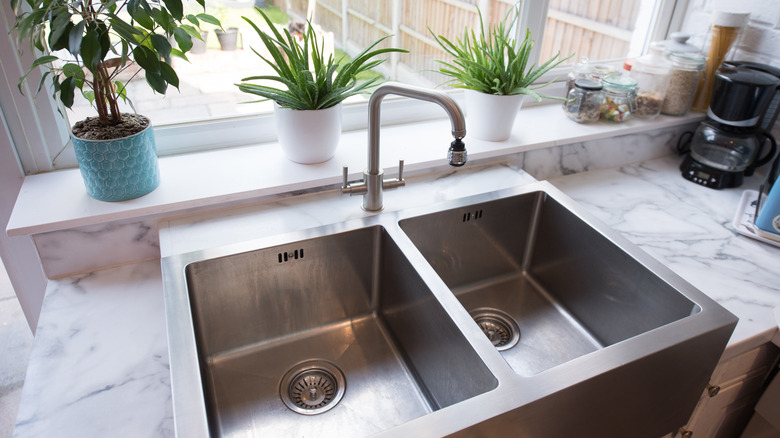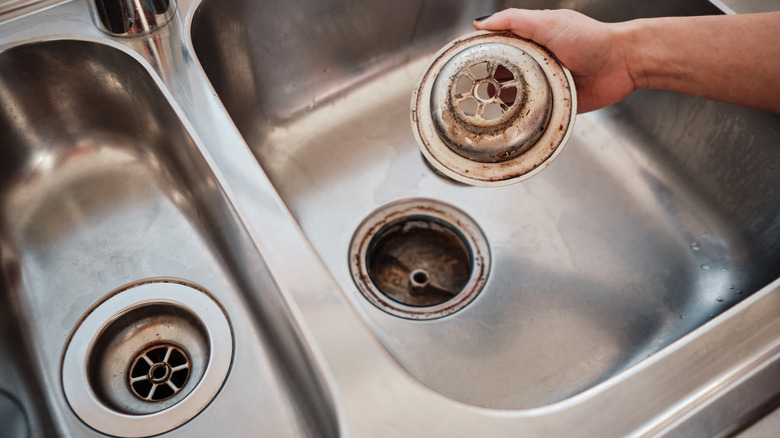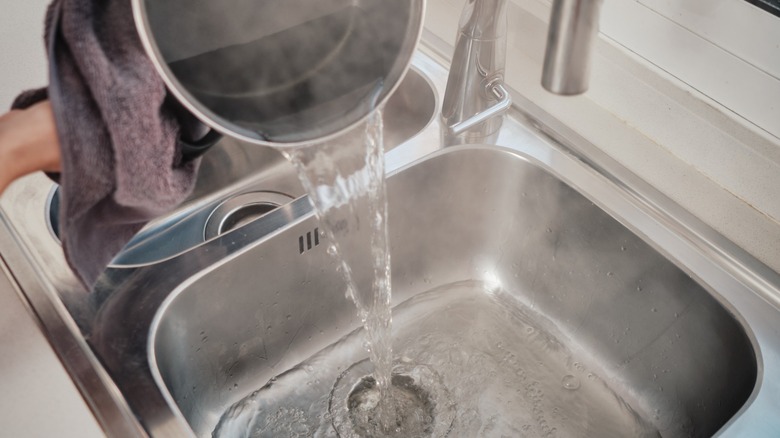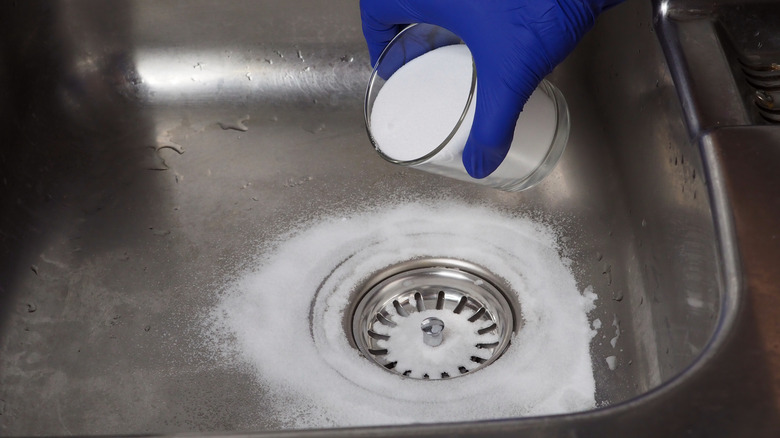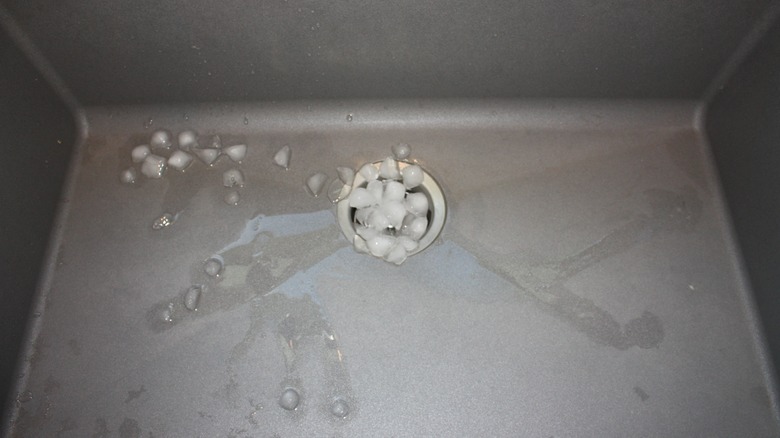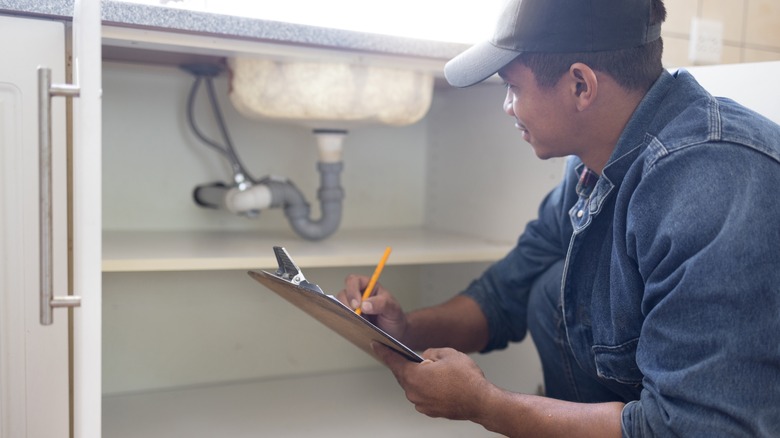Reasons Your Kitchen Sink Could Smell (& How To Fix It)
Stepping into the kitchen only to be sidelined by the awful smell wafting from the sink is no one's idea of a good time. While a slight odor may not be a big deal — and you might even get away with masking it with aromatic dishes or room fresheners — the problem will only get worse over time. This is because the odor-causing bacteria will thrive in the moist and dirty pipes and drains connected to the sink. Worse, the stuck food particles will continue rotting and clogging the pipes, giving way to a stench. Fortunately, there are multiple organic ways you can fix this pesky issue.
For starters, a plunger can help eliminate the unwanted clogs and the associated stench. Simply fill the sink halfway through and work your plunger into the drain a couple of times (or for about 20 seconds) — without letting the air in — to clear the channel. Ensure you plug in the other drain in case you have a double-sink model. Alternatively, use a toilet auger or drain snake to remove the offending particles and get rid of the smell. However, if these techniques don't help, we have four more DIY methods up our sleeve to eradicate the foul odor. That being said, if none of these methods work, you might have to call a professional to take care of the issue. Also, steer clear of chemical drain cleaners since they can corrode the pipes, causing them to leak or burst.
Common reasons why your kitchen sink smells awful
Bacteria is what's really causing your drain to stink. After all, your dirty, food-ridden, and moist pipes and drain are the dream for microscopic bacteria. So, it breeds rapidly in the dank environment and shamelessly wolfs down the rotting food for nourishment. The more bacteria that inhabit the channel, the worse the smell you'll have to deal with. Besides, the bacteria inhabiting the pipes can be detrimental to your health. In a similar vein, the oils and fats from the stuck food particles lead to clogs, turning your sink smelly and making it difficult for water to easily pass through the pipes.
A dirty garbage disposal with buildup on its blades might make your nose curl. Another common reason your kitchen sink smells is a high concentration of sulfates in the tap water. These components don't just make your drain smell bad — they could also block the pipes. Sewer gas escaping from the P-trap or plumbing vent pipe could also be behind your stinky kitchen sink.
But if you've ruled out stuck food particles, don't have a dry P-trap, clean your garbage disposal and the pipes regularly, and the sulfate concentration isn't alarming, you might want to check for leaks. A leak directly beneath your sink will invite mold and mildew and trick you into thinking the problem is with your drainage. Faulty pipework involving disjointed parts or undetectable leaks might also be to blame.
Pour boiling hot water down the drain
If you don't fancy sharing your drain with staph or salmonella-causing bacteria and the thought of stuck food particles is enough to give you nightmares, arm yourself with boiling hot water to get rid of the organisms along with the stench. Start by draining any accumulated water in your sink and boiling about 2 liters of water. Once the water starts boiling, pour the contents down the drain to unclog the pipes. You could even add a few drops of lemon juice or your favorite essential oils to the water for a fresh-smelling kitchen. After five minutes, chase away the hot water with the same amount of cold water to eliminate the stuck mess.
While effective, there are a few caveats to this method. One, you might not want to try this out if you have a garbage disposal since it can fill with water. Two, you want to assess your pipe's material before pouring liters of boiling water down the sink. To illustrate, metal pipes are good to go, but poor quality plastic or PVC pipes might not hold up to the pressure — although hot water, not boiling, might work in a jiffy. The pipes could dissolve or get warped with time, especially if you use this method often. Additionally, the boiling water trick will only work on small clogs. It won't have much of an impact on majorly blocked drain systems.
Use vinegar and baking soda to fight significant clogs
White vinegar is ideal for cleaning smelly clogs bogging down your pipes. Pour a cup of white vinegar down your kitchen sink and let it work its magic for half an hour before taking a similar approach with hot water. However, if this doesn't work, make your own DIY drain cleaner using baking soda and vinegar. All you have to do is measure out a cup of each ingredient. Once you have them, decant the baking soda cup prior to adding the vinegar.
Let the two ingredients react with each other. The fizzy chemical reaction will cut through the clogs and layers of grease, eradicating the foul odor in the process. For best results, leave them be for around two hours. If you can't leave the sink for hours on end, at least give the organic cleaners 10 to 15 minutes to clear the smelly blockage. Don't forget to plug the second sink if you have one. You should also cover the first sinkhole to prevent the resultant gas from escaping and adding to the pressure. After the time is up, boil some water and pour it down the drain to wash away the remnants of your DIY cleaner and kill any lingering bacteria.
Run ice cubes, coarse salt, and lemon peels through your garbage disposal
The garbage disposal is one out of sight, out of mind place you're most likely forgetting to clean. So, if your pipes are in the clear and aren't the culprit behind your smelly kitchen, you might want to clean your garbage disposal. But before you do anything, turn off the power supply and unplug the appliance. Then, grab a few ice cubes and some coarse salt to clean the blades. If you don't have kosher salt handy, regular table salt will do the trick. You might also want to break the ice into smaller chunks in case you have a large block.
Put 2 cups of ice cubes and a handful (about 1 cup) of salt into the sinkhole, turn on the tap water, and power on the appliance for 10 to 15 seconds, or until there's no more ice left in the sink. This simple action will remove the built-up gunk from the insides of your garbage disposal, effectively eliminating the smelly decaying food particles. To make the feature smell clean and fresh, peel off the rind from a lemon and add it to the disposal. Ensure the tap is running when you run the appliance to avoid accidental buildup. If you don't have lemons handy, use the peels of another citrus fruit, such as an orange, to naturally freshen your garbage disposal.
Check your P-trap for blockages or leaks
In case none of the solutions help in ridding your kitchen of the awful smell, you might want to check your P-trap, the U-shaped pipe located beneath the sink. Its main job is to prevent sewer gas and other awful smells from entering your home while simultaneously accumulating the debris passing through the sinkhole, keeping them from clogging the plumbing. But the trap must remain moist to do its job properly. So, if you rarely use the kitchen or are coming home after a long vacation, pouring water down the drain or turning on the tap should take care of the smelly P-trap situation for you.
Otherwise, you need to clear the buildup from the trap. Look for a cap at the bottom of the pipe called "cleanout" to remove the debris. Pull on your protective gloves, glasses, and face mask to minimize direct contact with the gunk or inhaling the unhealthy and flammable sewer gas. Put a towel and bucket directly under the cleanout and twist it off the trap. Pull out the gunk and rinse it before placing it back. If the trap doesn't have a pull-out cleanout, you might have to wrench free the P-trap or use a sink plunger to clear the clogs. You also want to check for leaks and replace the faulty components. While at it, take a quick look at the venting pipes, too, or contact a professional.
